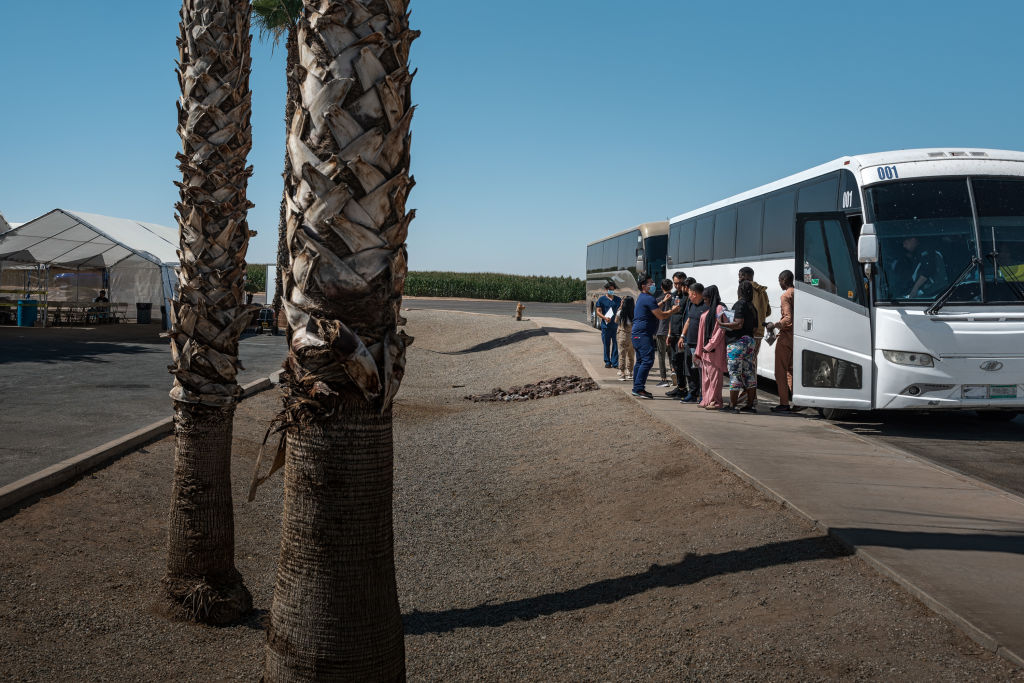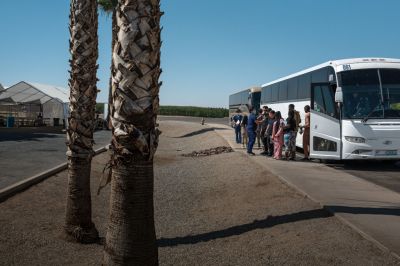When Title 42—a Trump-era public health regulation that allowed authorities to summarily dismiss asylum-seekers at the border—expired last month, some worried that the number of people attempting to enter the United States through the southern border would surge.
A Department of Homeland Security (DHS) statement released earlier this month claims these concerns haven't materialized. The number of “encounters” at the border—which includes apprehensions by Border Patrol and those declared inadmissible at regular ports of entry—declined in the four weeks after Title 42 was revoked on May 11.
The Biden administration is breathing a sigh of relief, declaring that its policy is working. But the precise cause for declining encounters is up for debate.
Border crossings post-Title 42.
Leading up to Title 42’s expiration, it was widely reported that officials projected a surge of as many as 10,000 daily border encounters. Average daily encounters in April stood at approximately 7,000.
But immigration authorities recorded just 3,700 daily unlawful attempts after the regulation ended on May 11. According to an analysis by Politico, that is a third the total recorded immediately before Title 42’s revocation.
The lower rate of crossings appears to be holding. In the last week, border officials recorded 22,778 encounters, or approximately 3,250 per day, according to Chief of Border Patrol Raul Ortiz.
What’s the bigger picture?
DHS claims that “border encounters remain low” and that “the administration’s plan is working as intended.” Much of the recent slowdown, however, likely owes to uncertainty about the direction of future policy rather than a long-term decline in numbers, according to Aaron Reichlin-Melnik, policy director at the American Immigration Council.
“We are facing unprecedented global displacement,” he tells The Dispatch. “Push factors in the home countries are often just as strong as pull factors to the United States, and we can’t do much about that.”
“Every time there is a major change in border policy you see migrants and smuggling agents take a pause to assess the state of the border.”
This year’s numbers have fluctuated as President Biden attempts to increase penalties for illegal entry while enticing incoming migrants to use new pathways for legal entry. There was a 40 percent drop in border encounters following the expansion of parole sponsorship programs for Cuban, Haitian, and Nicaraguan nationals, and the implementation of harsher penalties for those groups attempting to arrive via Mexico.
These new pathways, however, remain heavily oversubscribed. According to data gathered by CBS, there were more than 10 times as many applicants for parole sponsorship by the end of April as there were spaces. U.S. Customs and Border Protection’s new CBP One App, designed to streamline the asylum interview process, is also straining.
Title 42 was designed to deter irregular migration during the pandemic, but its lack of penalties encouraged repeat encounters, which inflated recent statistics. Revoking the rule should therefore reduce the balance sheet, and that might explain some of the recent drop in encounters.
But the extent of the long-term problem is visible in other measures. The number of observed successful unlawful entries—“gotaways”—has quadrupled in three years, according to one DHS report. Meanwhile, encounters at the Canadian border are substantially higher than in previous years—over 50 percent higher this April than last—as more people seek to bypass restrictions from Mexico by flying north.
The total number of nationwide encounters is still slightly higher than last year’s, though recent policy changes are yet to take full effect.
How is the border issue likely to develop?
The Biden administration knows that the border issue isn’t going away. It is, as DHS says, an “entrenched challenge” that executive action alone “cannot solve.”
Since May, the department has introduced a slew of initiatives to encourage lawful migration, including regional processing centers in Latin America. One of them, recently opened in Costa Rica, will allow Venezuelans and Nicaraguans residing there to apply for asylum directly.
Long-term immigration patterns, however, are likely to remain a thorn in the side of this administration and the next. Three state lawsuits on the Trump-era asylum transit ban—which limited entry pathways for non-Mexican nationals arriving—remain in court. Meanwhile, the administration is still undecided about reinstating family detention after floating the idea in March.
“Policy remains in limbo because Congress won’t do anything,” says Reichlin-Melnik, adding that, “the presidency is patching on policies that Congress didn’t necessarily envision for the modern era.”





Please note that we at The Dispatch hold ourselves, our work, and our commenters to a higher standard than other places on the internet. We welcome comments that foster genuine debate or discussion—including comments critical of us or our work—but responses that include ad hominem attacks on fellow Dispatch members or are intended to stoke fear and anger may be moderated.
With your membership, you only have the ability to comment on The Morning Dispatch articles. Consider upgrading to join the conversation everywhere.